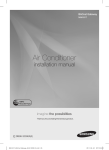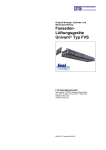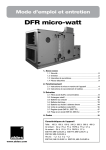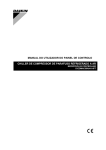Download BACnet/IP communication with POL908.00
Transcript
BACnet/IP
POL908 / POL6XX
POL908 / POL6XX
POL908 / POL6XX
Climatix™
BACnet/IP communication with POL908.00
Integration guide
CB1J3962en
26.03.2010
Building Technologies
Siemens Switzerland Ltd.
Building Technologies Group
International Headquarters
Gubelstrasse 22
CH-6301 Zug
Tel. +41 41-724 24 24
Fax +41 41-724 35 22
www.siemens.com/sbt
© 2010 Siemens Switzerland Ltd.
Subject to change
2 / 30
Siemens
Building Technologies
BACnet/IP communication with POL908.00
CB1J3962en
2010-03-26
Table of contents
1
About this document .............................................................................. 5
1.1
Revision history ......................................................................................... 5
1.2
Before you start ......................................................................................... 5
1.3
Reference documents ............................................................................... 5
1.4
Document conventions ............................................................................. 6
1.5
Important information on safety ................................................................ 7
1.6
Trademarks and copyrights ....................................................................... 8
1.7
Quality assurance ..................................................................................... 8
1.8
Document use/ request to the reader ....................................................... 8
2
BACnet/IP overview ................................................................................ 9
2.1
Networks and addressing ......................................................................... 9
2.2
BACnet/IP limits ...................................................................................... 10
2.3
Climatix BACnet server functionality ....................................................... 11
3
Commission instructions ..................................................................... 13
3.1
BACnet/IP module, elements .................................................................. 13
3.2
Connect BACnet/IP module .................................................................... 14
3.3
Configure module via HMI ...................................................................... 15
3.4
Configure module on web page .............................................................. 17
3.5
Configure BBMDs ................................................................................... 18
4
Integration .............................................................................................. 21
4.1
General ................................................................................................... 21
4.2
BACnet objects types .............................................................................. 21
4.3
BACnet objects ....................................................................................... 22
4.4
Export EDE files ...................................................................................... 24
4.5
Configure Climatix as client .................................................................... 24
5
Other information .................................................................................. 25
5.1
Troubleshooting, tips ............................................................................... 25
5.2
FAQ on TCP/IP ....................................................................................... 26
Index
................................................................................................................ 29
3 / 30
Siemens
Building Technologies
BACnet/IP communication with POL908.00
Table of contents
CB1J3962en
2010-03-26
4 / 30
Siemens
Building Technologies
BACnet/IP communication with POL908.00
Table of contents
CB1J3962en
2010-03-26
Version
1
About this document
1.1
Revision history
Date
Changes
26.03.2010
First edition
1.2
Validity
Section
Pages
Before you start
This document applies to the following product:
Name
BACnet/IP communication module
Type (ASN)
POL908.00/STD
Short name
BACnet/IP module
Product versions
Description and functional scope of the products are based on the Climatix Valid
Version Set 8.0 or higher and application based on Siemens standard.
Target audience
This document is intended for the following audience:
BACnet system integrators
Measuring and control engineering staff
Sales and commissioning staff
Prerequisites
The above target audience:
Has general professional knowledge on planning and commissioning HVAC
technology measuring and control solutions.
Has basic knowledge of BACnet.
Has the additional reference addresses documentation for the specific product.
1.3
Further information
Reference documents
The following documents contain additional information on the products described
in this manual:
Document
Order no.
Data sheet "Communication module BACnet/IP"
CB1Q3933en
Basic documentation "BACnet communication modules"
CB1P3933en
Basic documentation "BACnet PICS"
CB1P3939en
BACnet objects "BACnet/IP communication with POL908.00" CB1Y3963en
Note! Uniqe documentation for each application.
Basic documentation “Standard Application AHU”
CB1P3977en
5 / 30
Siemens
Building Technologies
BACnet/IP communication with POL908.00
About this document
CB1J3962en
2010-03-26
1.4
Symbols used
Document conventions
Below is an overview of all symbols used in this document denoting risks or
important information:
This symbol draws your attention to special safety notes and warnings. Failing to
observe these notes may result in injury and/or serious damages.
STOP
This symbol denotes special information that, when failed to observe, may result in
faulty functionality or loss of data.
Notes with this symbol provide important information that requires appropriate
attention.
This symbol marks passages containing tips and tricks.
Abbreviations
The following abbreviations are used in text and illustrations:
Abbreviation
BACnet
BSP
Climatix
Gateway
HMI
HMI-DM
HVAC
MS
SELV
TCP/IP
Meaning
Building Automation and Control Network
Board Support Package (operating system)
Controller family with common tools
A device for transfer data between different kind of networks
Human Machine Interface, e.g Operator unit
Climatix Dot Matrix HMI, POL895.51
Heating, Ventilating, Air Conditioning
Management Station
Safety Extra-Low Voltage
Transmission Control Protocol, e.g. Ethernet/Internet
6 / 30
Siemens
Building Technologies
BACnet/IP communication with POL908.00
About this document
CB1J3962en
2010-03-26
1.5
Important information on safety
Field of application
Use Modbus communication only for control and monitoring.
Intended use
Trouble-free and safe product operation of the above products presupposes
transport, storage, mounting, installation, and commissioning as intended as well
as careful operation.
Electrical
installation
Fuses, switches, wiring and grounding must comply with local safety regulations for
electrical installations.
Wiring
When wiring, strictly separate AC 230 V mains voltage from AC 24 V safety extralow voltage (SELV) to protect against electrical shock!
Commissioning and
maintenance
Only qualified staff trained accordingly may prepare for use, commission, and
maintain Modbus communication modules.
Maintenance
Maintenance of Climatix Controller and Modbus communication modules generally
only means regular cleaning. We recommend removing dust and dirt from system
components installed in the control panels during standard service.
Faults
Only authorized staff may diagnose and correct faults and recommission the plant.
This applies to working within the panel as well (e.g. testing or changing fuses).
Storage and transport
Refer to the environmental conditions specified in the respective data sheets for
storage and transport.
If in doubt, contact your supplier.
Disposal
Devices contain electrical and electronic components; do not dispose of them in
household garbage.
Observe all local and applicable laws.
7 / 30
Siemens
Building Technologies
BACnet/IP communication with POL908.00
About this document
CB1J3962en
2010-03-26
1.6
Trademarks, legal
owners
Trademarks and copyrights
The table below lists the third-party trademarks used in this document and their
legal owners. The use of trademarks is subject to international and domestic
provisions of the law.
Trademarks
BACnet
Legal owner
American National Standard (ANSI/ASHRAE 135-1995)
All product names listed in the table are registered (®) or not registered (™)
trademarks of the owner listed in the table. We forgo the labeling (e.g. using the
symbols ® and ™) of trademarks for the purposes of legibility based on the
reference in this section.
Copyright
This document may be duplicated and distributed only with the express permission
of Siemens, and may be passed on only to authorized persons or companies with
the required technical knowledge.
1.7
Document contents
Quality assurance
These documents were prepared with great care.
The contents of all documents are checked at regular intervals.
All necessary corrections are included in subsequent versions.
Documents are automatically amended as a consequence of modifications and
corrections to the products described.
Please make sure that you are aware of the latest document revision date.
1.8
Document use/ request to the reader
Request to the reader
Before using our products, it is important that you read the documents supplied
with or ordered at the same time as the products (equipment, applications, tools
etc.) carefully and in full.
We assume that persons using our products and documents are authorized and
trained appropriately and have the technical knowledge required to use our
products as intended.
Exemption from liability
Siemens assumes no liability to the extent allowed under the law for any losses
resulting from a failure to comply with the aforementioned points or for the improper
compliance of the same.
8 / 30
Siemens
Building Technologies
BACnet/IP communication with POL908.00
About this document
CB1J3962en
2010-03-26
BACnet/IP networks
2
BACnet/IP overview
2.1
Networks and addressing
A BACnet/IP network consists of one or more IP subnets (IP domains) assigned the
same BACnet network number.
MS
ML
BACnet / IP
XXX.XX.X.X
R
R
AL
BACnet / IP
BACnet / IP
172.16.0.0
172.17.0.0
FL
A
ML
AL
B
Management level
Automation level
R
FL
P3933Z14
Router
Field level
Broadcasts and BBMDs
BACnet often uses broadcasts for communication. In contrast to unicasts, they are
intended for all network members.
This must be considered when engineering IP subnets. BACnet uses the "BACnet
Broadcast Management Device" (BBMD) as showed below.
One IP subnet
Broadcast messages from a device (e.g. 172.16.255.255:0xBAC0) in BACnet/IP
networks consisting of only one IP subnet are sent to all other subnet members as
IP broadcasts without requiring an additional measure. Example:
172.16.0.0
Several IP subnets:
BBMDs required
P3933Z09
BBMDs transmit broadcasts to all other BBMDs on the BACnet network, thus
distributing broadcasts across the corresponding subnets. Example:
XXX.XX.X.X
IP Router
IP Router
BBMD
More information
J3962Z03
172.17.0.0
172.16.0.0
BBMD
For more detailed information on BACnet/IP networks see documentation:
CB1P3933en "Climatix BACnet communication modules POL904, POL908".
9 / 30
Siemens
Building Technologies
BACnet/IP communication with POL908.00
BACnet/IP overview
CB1J3962en
2010-03-26
2.2
DHCP rules
STOP
BACnet/IP limits
Automatic assignment of DHCP may have an undesired effect on the system.
Remember the following:
Item
BBMDs
Alarm recipient
Access rights
IP version
Rules
DHCP may never be used together with "BACnet Broadcast
Management Devices" (BBMDs), as the IP addresses of the
"Broadcast Distribution Table" (BDT) are configured as static
addresses and cannot change during operation.
In BACnet, alarm recipients are entered with their "Device
Object Identifier" or their BACnet address. The IP address is
part of the BACnet address and may not be changed for the
alarm recipient.
For this reason, option "Device Object Identifier" must
always be used.
If access rights are assigned based on IP address (e.g. for
firewalls), the address must be static.
The BACnet standard currently supports only IP Version 4,
i.e. only IP devices with 32 bit address that can be operated
as BACnet/IP device. The BACnet protocol does not work
with 128-bit addresses of IPv6.
10 / 30
Siemens
Building Technologies
BACnet/IP communication with POL908.00
BACnet/IP overview
CB1J3962en
2010-03-26
2.3
Climatix BACnet server functionality
Supported standard
The BACnet/IP module supports BACnet standard B-AAC (BACnet Advanced
Application Controller).
Limits for objects and
COVs
Limits for objects and COV subscriptions:
Object types supported
The BACnet/IP module supports the following BACnet standard object types:
Item
Objects in device, total
BACnet objects, portion of total number
Simultaneous COV subscriptions
COVs on BACnet
Climatix object
Clock
aoDeviceGroup
aoDiagnostic
aoAnalogInput
aoAnalogOutput
aoAnalogValue
aoSetpointValue
aoDisplayValue
aoSetpointValueLimit
aoBinaryInput
aoBinaryOutput
aoBinaryValue
aoMultistateInput
aoMultistateOutput
aoMultistateValue
aoSetpointMultistate
aoDisplayMultistate
aoSchedule
aoScheduleWord
aoCalendar
MessageClass
Number
max. 500
max. 300
max. 50
max. 5 per sec
BACnet object
Device
Device
Device
AnalogInput
AnalogOutput
AnalogValue
AnalogValue
AnalogValue
AnalogValue
BinaryInput
BinaryOutput
BinaryValue
MultiStateInput
MultiStateOutput
MultiStateValue
MultiStateValue
MultiStateValue
Schedule
Schedule
Calendar
NotificationClass
Comment
No Alarm
No Alarm
No Alarm
No Alarm
No Alarm
No Alarm
No Alarm
No Alarm
No Alarm
In the future, this device may support other objects such as "LoopController" or
"Trend".
For information on the current status, see:
CB1P3939en "Protocol Implementation Conformance Statement (PICS)"
Different alarm
handling
Alarms of a BACnet client are handled differently from those of Climatix:
– In BACnet, each objects in alarm is acknowledged and reset as well as
transitioned from "ToNormal", "ToOffNormal", and "ToFault".
– Climatix objects do not support this transition, but rather only transitions to
"ToNormal". This is done via general acknowledgement for each object, not for
each individual object in alarm.
The behavior described above means that acknowledgement and reset in BACnet
does not impact pending/unhandled alarms in Climatix.
Acknowledgement in BACnet is only information that the alarm has been identified.
Workaround
The following workaround is needed to reset a BACnet alarm:
An additional BACnet object "MultiStateValue" named "Reset" is used for general
acknowledgement in Climatix.
11 / 30
Siemens
Building Technologies
BACnet/IP communication with POL908.00
BACnet/IP overview
CB1J3962en
2010-03-26
BACnet server functionality, continued
Multistate objects
BACnet does not use the value 0 for Multistate objects. All Multistate objects start
with 1. Climatix may use Multistate objects even if there are only 2 states (e.g.
Off/On).
See the following document for "BACnet Interoperability Building Blocks" (BIBBs)
and standard object types etc. supported:
CB1P3939en "Protocol Implementation Conformance Statement (PICS)"
Schedule and Calendar
The figure shows the Climatix schedule concept for BACnet:
BACnet Schedule
Effective Period
Mo
...
...
...
Sun
Start Date
End Date
BACnet Calendar
Exeption Schedule
Weekley Schedule
Exeption Day
Date List
Calendar
Reference
P3933Z30
Monday
Time 1
Value 1
Time 2
Value 2
Time 3
Value 3
Time 4
Value 4
Time 5
Value 5
Time 6
Value 6
Explanations (figure)
REAL
UNSIGNED
Exeption Day
Time 1
Value 1
Time 2
Value 2
Time 3
Value 3
Time 4
Value 4
Time 5
Value 5
Time 6
Value 6
REAL
UNSIGNED
Choice 1
Choice 2
Choice ..
Choice ..
Choice ..
Choice 10
Date List
Date or Range or WeekDay
Date or Range or WeekDay
Date or Range or WeekDay
Date or Range or WeekDay
Date or Range or WeekDay
Date or Range or WeekDay
The elements and functions in the figure are:
Element
Function
BACnet Schedule BACnet object "Schedule" defines a weekday and exception
day program as well as an actual time period during which the
schedule is active.
Weekly Schedule Each day – from Monday to Sunday as well as the exception
day – allows for six different entries "Time/Value". Value
REAL(FLOAT), DIGITAL, or UNSIGNED (multistate) depends
on the Climatix object connected to the program.
Exception
Climatix only offers one exception day. It refers to the BACnet
Schedule
Calendar object. The exception day is defined like any day of
the weekly schedule. The BACnet calendar then determines
when the exception day is active. It takes priority over the
weekly schedule.
BACnet Calendar The BACnet "Calendar" object is a list with "Date" or "Range"
Exception
or "WeekNDay" (weekday) entries. The exception day of a
related schedule is active when the entry is selected via the
BACnet calendar.
BACnet Calendar The BACnet "Calendar" object is a list with "Date" or "Range"
Off
or "WeekNDay" (weekday) entries. The plant is set to off
when the entry is selected via the BACnet calendar.
Date defines a start date. The present value is active for this
Date
date.
– Example 1: *,07/04/25 (April 25, 2007).
th
– Example 2: Sun,*/04/25 (each 25 of April, provided it is a
Sunday).
Date range defining start and end date. The present value is
Range
active for this range.
Entry format: Same as for Date.
WeekDay
This entry allows for selecting a special day as exception day.
Entry format:
Week of month (number), day (name), month.
– Example 1: 02/Mo/Mar (second Monday in March, every
year).
– Example 2: */Tu/* (every Tuesday).
12 / 30
Siemens
Building Technologies
BACnet/IP communication with POL908.00
BACnet/IP overview
CB1J3962en
2010-03-26
Commission instructions
3.1
BACnet/IP module, elements
The figure shows the Climatix BACnet/IP module POL908.00/STD. It is connected
to the Climatix controller via the internal communication extension bus. This is
done via plug connection on the left side of the controller.
P3933Z05
Design
3
5
4
SIEMENS
SIEMENS
POL908.00/
Ethernet
BSP
1
1
BUS
3
2
Elements and
connections
The elements and connections in the figure are:
Pos. Element / Connection
1
Ethernet interface 10/100 Mbit (IEEE 802.3U), RJ45 plug, 8-pin.
2
Status display "BSP" (Board Support Package).
3
Status display "BUS" (bus connections / bus traffic o.k.).
4
Plug connection "Communication extension bus".
5
Climatix controller POL6XX.
Status LEDs
The status LEDs "BSP" and "BUS" can light red, green and yellow during
operation.
"BSP" LED
This LED informs on the status of the "Board Support Package" (BSP). Color and
flashing frequency of the LED:
Color
Flashing frequency
Meaning / Mode
Red / yellow 1 s "on" / 1 s "off"
Upgrade mode.
BSP operating and communication with
Green
Steady "on"
controller working.
BSP operating, but no communication with
Yellow
Steady "on"
controller.
Red
Flashing at 2Hz
BSP error (software error).
Red
Steady "on"
Hardware fault.
"BUS" LED
This LED shows the status of external communication with the bus, not to the
controller. Color and flashing frequency of the LED:
Color
Flashing frequency
Meaning / Mode
Green
Steady "on"
Communication active.
Red
Steady "on"
Communication interrupted.
Yellow
Steady "on"
Initializing – no communication yet via IP.
Power supply is outside the allowed range if both LEDs are dark.
13 / 30
Siemens
Building Technologies
BACnet/IP communication with POL908.00
Commission instructions
CB1J3962en
2010-03-26
3.2
Connect BACnet/IP module
Prerequisites for connecting and configuring:
Working application loaded and started in the Climatix controller.
Devices involved
The Climatix controller and the BACnet/IP communication module are involved in
this action:
BACnet / Ethernet IP
J3962Z02
POL908 / POL6XX
HMI-DM
PC
WEB
Tools needed
Tools needed for connecting and configuring:
– Operator unit (HMI-DM).
– PC with web browser.
Connect BACnet/IP
module
Proceed as follows to connect the BACnet/IP module to the bus:
Step
Action
1
Controller OFF.
2
Connect BACnet/IP module to the controller via plug connection.
3
Connect the TCP/IP bus cable to the module.
4
Controller ON:
The module starts / initialization begins.
As soon as the two LEDs "BSP" and "BUS" are steady green,
communication with the controller and bus (BACnet) is active.
Caution!
HMI-DM must be reset a second time to update; prior to
parameterization
Next: Configure
BACnet/IP module
Next job is to configure the BACnet/IP module. There are two possible tools for
configuring:
Configure via …
Operator unit (HMI-DM)
Module's web page
Job
TCP/IP settings preferred tool
TCP/IP settings alternative tool
BBMD settings only tool
Section
3.3
3.4
3.5
14 / 30
Siemens
Building Technologies
BACnet/IP communication with POL908.00
Commission instructions
CB1J3962en
2010-03-26
3.3
Basic settings /
parameters
Configure module via HMI
Use the operator unit (HMI-DM) to enter BACnet basic settings.
Actual values and status is showed in the main page of the module, all settings are
made in the sub pages for BACnet and TCP/IP.
Parameters
State
Comm failure
Device name
Device ID
Port
Imperial unit sys
Unicode
Description lang
SecurityLevel
Alarm server ID
Alarm device ID1-3
Comm mapping
(Language)
DHCP
WINS name
IP
Mask
Gateway
Software version
Use default
Procedure
Explanation
Current status of the communication module
Active = Communications error.
BACnet device name.
BACnet device ID.
BACnet port (UDP port), normally 0xBAC0 = 47808
Change dimensions to the imperial system.
Set the parameter to "active" ("passive" is default) if
Unicode characters are used.
Language for the description field in EDE file and the
description property on BACnet. The same texts as in the
HMI-DM are used.
Set security level for BACnet.
Unique Alarm server ID (range 0…15)
Fix recipient device 1-3
Determines the objectnames, "Languages", used for all
BACnet objects. Normally 16384 that is the same as
COM1.
DHCP active/passive. Passive = Fixed IP address
WINS name on the TCP/IP network.
Module IP. Actual in the main page for the module.
Module mask. Actual in the main page for the module.
Module gateway. Actual in the main page for the module.
Module BSP version.
Reset to default settings.
Proceed as follows to configure the BACnet/IP module step by step:
Step
1
2
3
4
5
Action
Log in to HMI-DM using the password for level 4 (Service), default 2000.
Go to Main Index > System overview > Communication > Comm
module overview > Module[x] BACnet IP >
Note! [x] is the position of the connected communication module. This is
only information used when more than one module is connected.
Go to TCP/IP settings >
The TCP/IP settings must be set up via HMI-DM to be able to connect to
the web interface where BACnet and BBMD settings also can be done.
Select DHCP:
Active means that the IP address is given from a DHCP server on the
network.
Passive means that a fixed IP address will be used as the settings
described below. Fixed IP address must be used if using BBMD.
Select IP, Mask and Gateway:
The IP settings for the module are used for a fixed IP address and are
only active if the DHCP parameter is set to Passive.
Note! End a line with #. Never use a “space” at the end.
These settings are not the same as the TCP/IP settings for the controller
if a controller with inbuilt TCP/IP is used.
15 / 30
Siemens
Building Technologies
BACnet/IP communication with POL908.00
Commission instructions
CB1J3962en
2010-03-26
Configure module via HMI, cont.
Step
6
Procedure, cont.
7
8
9
10
11
12
13
Action
Select Write settings:
Set Write settings to Active and go back to the main page of the module
with ESC. This must be done after any new change in this page.
Go to BACnet settings >
All settings except the Description language can also be done via the
web interface. In that case only select the Description lang and then go
to the last step.
Select Device name:
The Device name must be unique within the BACnet network.
The last part in the default name is taking from the mac address of the
module and is therefore always unique.
Select Device ID:
The Device ID must be unique within the BACnet network.
The default ID is always unique.
Select Port:
The default UDP port for BACnet is hexadecimal BAC0 (decimal 47808).
The Port can only be set up as decimal conversion (47808-47823).
BAC0=47808; BAC1=47809…BACF=47823
Select Description lang:
Language for the description field in EDE file and the description
property on BACnet. The same selections and texts as in the HMI-DM
are used.
Select Alarm device IDs:
Up to three fixed alarm recipients can be entered to have a fast update
of all alarms. Enter the BACnet device ID of the alarm recipient/client.
Select Reset required !!:
When done, restart controller using this command by first go back two
pages with ESC.
After restart, the BACnet module is configured and ready to use.
See further instructions how to set up BBMD if this must be used.
STOP
As a matter of principle, the controller must be restarted with “Reset required !!” or
power off/on the controller after changing any settings to assume the data.
Other setting than described above are only options and should normally not be
changed.
16 / 30
Siemens
Building Technologies
BACnet/IP communication with POL908.00
Commission instructions
CB1J3962en
2010-03-26
3.4
Configure module on web page
Two tasks
We differentiate between the following tasks:
1. Enter basic settings – if not done via operator unit (HMI-DM).
See this section.
2. Enter BBMD settings (incl. any foreign devices).
See section 3.5.
BACnet Config menu
The basic settings are entered via the BACnet Config menu:
P3933O04
Basic settings
Proceed as follows to enter the basic settings:
Step
1
2
3
4
5
6
7
STOP
Action
Enter the IP address or WINS name in the browser to open the module's
web page.
Select the tic for enable BACnet.
Language should normally be COM1 (16384). Same as Comm mapping
Select Device ID:
The Device ID must be unique within the BACnet network.
The default ID is always unique.
Select Device name:
The Device name must be unique within the BACnet network.
The last part in the default name is taking from the mac address of the
module and is therefore always unique
Select UDP Port:
The default UDP port for BACnet is hexadecimal BAC0 (decimal 47808).
The Port can only be set up as decimal conversion (47808-47823).
BAC0=47808; BAC1=47809…BACF=47823
UniCode should normally not be active.
Select Recipient devices:
Up to three fixed alarm recipients can be entered to have a fast update
of all alarms. Enter the BACnet device ID of the alarm recipient/client
Press the “Save all values” button.
Any changes on the BACnet Configuration Page needs a restart of the BACnet
server by Shutdown and Start the BACnet server again.
17 / 30
Siemens
Building Technologies
BACnet/IP communication with POL908.00
Commission instructions
CB1J3962en
2010-03-26
3.5
BBMD settings
Configure BBMDs
You must define and parameterize "BACnet Broadcast Management Devices"
(BBMDs) if a BACnet/IP network comprises several subnets. This allows for
broadcasts via routers to all network members.
BBMD settings can only be done via web.
Application example
without foreign device
The following network with two subnets only contains servers (controllers) and to
set connected clients (PCs). All members can communicate with each other if one
BBMD is defined per subnet.
10.169.8.xxx
A
10.169.8.84
R
139.16.77.xxx
B
139.16.77.126
"BBMD Settings"
window
P3933Z25
The web page for the corresponding controller offers the BBMD Settings window to
parameterize BBMDs (here: Controller A):
P3933O05
Settings
The window offers the following options:
Element
Description
Enable BBMD
Select BBMD function for this controller.
Update BBMD
Assume settings and refresh display.
Checkbox: Foreign Device Table yes / no
FDT present
Text field: Max. number of entries (possible foreign
devices).
Update FDT
Assume settings and refresh display.
Two-Hop Forwarding
Select two-hop forwarding.
Update Two Hops
Assume settings and refresh display.
IP address for the partner BBMD on other subnet, e.g. for
IP Address
the above case:
– Partner for controller "A": 139.16.77.126
– Partner for controller "B": 10.169.8.84
UDP Port
Same as in the basic BACnet settings.
Update
Assume settings and refresh display.
IP address for BBMD server in an third subnet. Important:
New
Enter the setting for all three BACnet servers!
18 / 30
Siemens
Building Technologies
BACnet/IP communication with POL908.00
Commission instructions
CB1J3962en
2010-03-26
Configure BBMDs, continued
Application example
with foreign device
The following topology contains:
Two BBMDs "A" and "B".
One foreign device "C" (MS / BACnet client).
MS
C
10.169.8.71
10.169.8.xxx
R
R
Site 1
Site 2
139.16.77.xxx
A
B
139.16.77.126
Settings for controller "A"
139.16.25.xxx
139.16.25.84
P3933Z26
Enter the settings again via window "BBMD Settings" for the respective controller:
P3933O06
Explanations
Differences to the application example without foreign device on the previous page:
1. Checkbox FDT present is selected.
2. Text field Max. Entries contains "1" (for MS "C").
Settings for controller "B"
Same settings as for controller "A", but with the following difference:
The IP Address is 139.16.77.126
Other setting than describe above are only options and should normally not be
changed
STOP
FD settings in BACnet
client (C)
Any changes on the BACnet Configuration Page needs a restart of the BACnet
server by Shutdown and Start the BACnet server again.
Enter the IP addresses of the BBMDs, i.e. for controllers "A" or "B".
19 / 30
Siemens
Building Technologies
BACnet/IP communication with POL908.00
Commission instructions
CB1J3962en
2010-03-26
Blank page
20 / 30
Siemens
Building Technologies
BACnet/IP communication with POL908.00
Commission instructions
CB1J3962en
2010-03-26
4
Integration
4.1
General
Climatix can be integrated to any BACnet client that supports BACnet/IP. Special
care must be taken to the BACnet standard and what object types and properties
that are supported both on the Climatix and the client side.
4.2
Overview
BACnet objects types
Climatix supports the object types listed below:
Object type
Supported
Analog Input
Analog Output
Analog Value
Binary Input
Binary Output
Binary Value
Calendar
Command
Device
Event Enrollment
File
Group
Loop
Multi-State Input
Multi-State Output
Multi-State Value
Notification Class
Program
Schedule
Averaging
Trend Log
Life-Safety-Point
Life-Safety-Zone
Accumulator
Pulse-Converter
Description
Can be created
dynamically
Can be deleted
dynamically
See the following basic document for a detailed description of the individual object
types:
CB1P3939en
"BACnet Protocol Implementation Conformance Statement (PICS)"
21 / 30
Siemens
Building Technologies
BACnet/IP communication with POL908.00
Integration
CB1J3962en
2010-03-26
4.3
Use the right document
for actual application
BACnet objects
All available BACnet objects are found in a separate document and are specific for
the actual application. All different applications, and in some cases also application
versions, have different BACnet objects. The specific document for the actual
application must be used to see what BACnet objects that are used.
The actual application name and version can be found using the HMI-DM. In some
cases it is also good to check the controller BSP version.
Check actual
application
Proceed as follows to see the actual application name and version:
1. Log in to HMI-DM using the password for level 4 (Service), default 2000.
2. Select Main Index > System overview > Application info >
Parameter
Application manufacturer
Application name and version
Date
Name
Street
City
Check actual controller
BSP version
Explanation / Example
e.g. Siemens
e.g. STD_AHU_vX.XX
Application creation date; can be changed
by application manufacturer
e.g. plant name.
e.g. plant address.
e.g. plant address.
Proceed as follows to see the actual controller BSP version:
1. Log in to HMI-DM using the password for level 4 (Service), default 2000.
2. Select Main Index > System overview > Target >
Parameter
BSP version
Explanation / Example
Controller operating system.
All present BACnet objects for the specific unit are found in the EDE files.
See next chapter how to export the EDE files.
22 / 30
Siemens
Building Technologies
BACnet/IP communication with POL908.00
Integration
CB1J3962en
2010-03-26
BACnet objects, continued
Priority array definition
Climatix uses the command priority levels according to the following table:
Priority
level
1
2
3
4
5
6
7
8
9
10
11
12
13
14
15
16
Usage
Remarks
Service, configuration
Not used
Not used
Alarm or force
Force
Min runtime
Not used
Manual control from HMI
Room unit
Set back analog outputs
to NULL
Not used
Not used
Not used
Communication control
Normal control
Time switch program
Output always 0
Output always 0
Output according to settings
Output keeps the last state for set time
Output according to selected value
Default value
23 / 30
Siemens
Building Technologies
BACnet/IP communication with POL908.00
Integration
CB1J3962en
2010-03-26
4.4
What are EDE files?
Export EDE files
EDE = "Engineering Data Exchange" is the format recommended by the BACnet
Interest Group Europe to exchange data between BACnet server and BACnet
client.
EDE Export files containing information on the BACnet objects are required for
offline integration in a management station if it is not supports online integration.
The EDE files are created by the BACnet server at every start of the server. It is
needed to download and import new files if there is any change in controller
configuration, that adds new BACnet objects, or change in BACnet settings.
Procedure for export
These files can be exported via ftp as follows:
Step
Action
1
Open ftp for the module in the browser (Internet Explorer):
ftp://IP address of the module.
2
Go to Temp and save the two files selected in the screenshot below.
P3933O09
The EDE files are then used for offline integration, but could also be open in Excel
to view what BACnet objects that are present.
Normally can either the object-name or the object-instance be used as a BACnet
reference.
4.5
Configure Climatix as client
Description planned for the next version.
24 / 30
Siemens
Building Technologies
BACnet/IP communication with POL908.00
Integration
CB1J3962en
2010-03-26
5
Other information
5.1
Troubleshooting, tips
General
General things to check:
Check the actual application version and controller BSP version before call any
support.
As a matter of principle, the controller must be restarted with “Reset required !!”
or power off/on the controller after changing any settings to assume the data.
TCP/IP network
Observe the following for TCP/IP network design and structure:
Check that the DHCP parameter is set to “Passive” if fixed IP address should be
used.
Try to ping the controller if the communication is not working. If the ping fails
something is wrong in the network or the IP settings.
Check that the defined UDP port, e.g. BAC0, is open in the firewall.
Use the character # at the end of all IP settings. Never use a “space” at the end.
BACnet does not work
Check the following if BACnet does not work:
Does the BACnet server run in the Process Manager (web)?
File "BACnetApp.exe" must be visible.
Do the EDE files exist?
Otherwise, start the BACnet server on the BACnet page.
BBMDs required?
BBMD must be used if BACnet client and BACnet server are located in different
subnets.
Use command "tracert" to check this.
Example (result):
Tracert shows all stations used to forward the signal to another segment.
Device Name and ID
unique?
Make sure both Device Name and die Device ID are unique within the BACnet
network.
Note BACnet multistate
objects
BACnet multistate objects do not use value "0". They always start at "1".
25 / 30
Siemens
Building Technologies
BACnet/IP communication with POL908.00
Other information
CB1J3962en
2010-03-26
5.2
TCPI/UDP ports
FAQ on TCP/IP
Port number
21
23
80
4242
47808
47809
47823
Type
UDP
TCP
UDP
UDP
UDP
Used for …
FTP
Telnet/Ping
Web
Scope, RemoteOPC TCP/IP
BAC0
BAC1
BACF
IP address
The IP address is assigned either dynamically via the DHCP server or set manually
via HMI-DM as follows:
Step
Action
1
Set parameter DHCP to Passive.
2
Change IP address.
3
Confirm by setting Write settings to Active.
4
Restart controller.
MAC address and WINS
name
The MAC address is the topmost number of the sticker on the communication
module POL908. It always follows the same form: "00 A0 03 FF XX XX XX", where
XX XX XX is a continuous number.
Example: 00 A0 03 FF 2C 9D
The WINS name is generated from the prefix POL908_ and XX XX XX (i.e. the last
six digits of the MAC address).
Example: POL908_FF2C9D
You can also find the WINS name in the configuration settings in the HMI-DM.
Web server
Use the WINS address or IP address to successfully connect to the web server.
Example: "http://POL908_XX XX XX" or "http://192.168.0.10"
The web server uses TCP port 80 for communication.
FTP server
Use the same address as for the web server, but replace
"http://" by "ftp://ADMIN@" to successfully connect to the FTP server.
Example: "ftp://ADMIN@POL908_FF2C40"
The following setting must be selected in the Internet Explorer:
Tools > Internet Options > Use Passive FTP (for compatibility with firewalls and
DSL modem).
Password
User name:
Password:
ADMIN
SBTAdmin!
26 / 30
Siemens
Building Technologies
BACnet/IP communication with POL908.00
Other information
CB1J3962en
2010-03-26
FAQ on TCP/IP, continued
Network:
Disconnected
Ping the communication module using the WINS or IP address to test
communications:
Step
Action
1
Select Start > Run on the Windows start bar:
The "Run" dialog box opens.
2
Enter CMD and click OK:
The "CMD.exe" DOS window opens.
3
Enter C:\>ping POL908_XX XX XX and press Enter:
The ping result is displayed.
You are dealing with a network or IP settings error if pinging does not work.
Problems with security
scan
The SNMP service (Simple Network Management Protocol) may present a problem
during a security scan by the network administrator.
You can disable the SNMP service.
27 / 30
Siemens
Building Technologies
BACnet/IP communication with POL908.00
Other information
CB1J3962en
2010-03-26
Blank page
28 / 30
Siemens
Building Technologies
BACnet/IP communication with POL908.00
Other information
CB1J3962en
2010-03-26
Index
A
Abbreviations .......................................................... 6
E
EDE files ................................................................24
B
BACnet object types ............................................. 21
BACnet/IP limits .................................................... 10
BACnet/IP module
Elements ........................................................... 13
Status displays .................................................. 13
BACnet/IP networks and addressing ...................... 9
Before you start ...................................................... 5
Broadcasts and BBMDs.......................................... 9
F
FAQ on TCP/IP ......................................................26
C
Climatix BACnet server functionality .................... 11
Alarm handling .................................................. 11
Object types ...................................................... 11
Schedule ........................................................... 12
Commission
Configure BACnet/IP module ............................ 14
Configure BBMDs ............................................. 18
Configure module on web page ........................ 17
Configure module via HMI ................................. 15
Connect module ................................................ 14
D
Document use......................................................... 8
Document validity ................................................... 5
Documents, other ................................................... 5
I
Integration
BACnet object types ..........................................21
BACnet objects ..................................................22
Configure Climatix as client ...............................24
Export EDE files .................................................24
General ..............................................................21
Priority array definition .......................................23
Q
Quality assurance .................................................... 8
R
Revision history ....................................................... 5
S
Safety notes. ........................................................... 7
Symbols in document .............................................. 6
T
Target audience ....................................................... 5
Trademarks and copyrights ..................................... 8
Troubleshooting
FAQ on TCP/IP ..................................................26
Tips ....................................................................25
29 / 30
Siemens
Building Technologies
BACnet/IP communication with POL908.00
Index
CB1J3962en
2010-03-26
Siemens Switzerland Ltd.
Building Technologies Group
International Headquarters
Gubelstrasse 22
CH-6301 Zug
Tel. +41 41-724 24 24
Fax +41 41-724 35 22
www.siemens.com/sbt
© 2010 Siemens Switzerland Ltd.
Subject to change
30 / 30
Siemens
Building Technologies
BACnet/IP communication with POL908.00
CB1J3962en
2010-03-26




































